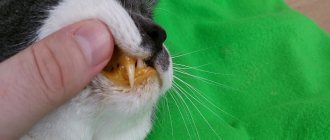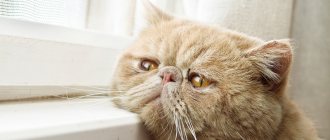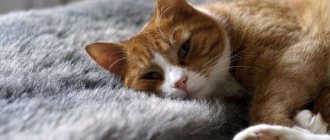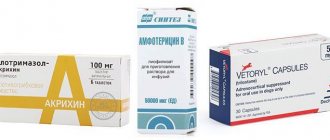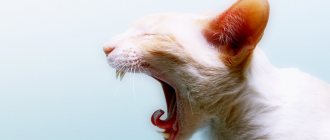Such a dangerous disease as epilepsy is a health problem not only for humans, but also for cats. Few “cat people” know about this; unfortunately, most of them do not understand the strange behavior of their pets.
Therefore, information about whether epilepsy occurs in cats, how an epileptic seizure occurs, and what to do in the event of an attack will be extremely useful for many.
Epilepsy in cats requires competent treatment, constant monitoring by a veterinarian, and attentive attitude towards the animal on the part of the owner. The disease brings suffering and pain to the cat, you need to try to help the pet in the fight against the disease, to alleviate its condition.
What is epilepsy and how often does it develop in cats?
Epilepsy (from ancient Greek - seized, caught) is a neurological disease that occurs as a result of disruption of the normal functioning of the pet’s brain. The disease can manifest itself as convulsive twitching of individual parts of the animal’s body, loss of consciousness with convulsions, or loss of orientation in space.
The disease rarely affects cats, the prevalence of the pathology is only 0.5–1%. There is an opinion that epilepsy develops more often in purebred animals, but there is no scientific confirmation of this fact. According to statistics, the pathology affects male animals to a greater extent, cats suffer less often. The disease is not related to the age of the pet and can appear at any period of life.
Massage technique for cramps
When an animal experiences seizures, it is necessary to secure it as soon as possible on a flat, soft surface, for example, on a bedding on the floor or carpet. A cramped muscle in a limb should be massaged immediately. Be careful! There is no need to be zealous, since even light stroking is enough to reduce the attack. After the massage, it is recommended to apply a heating pad or a warm bottle of water to the limb. Additionally, warming up the cat's lower back will relax the muscles.
What is the danger of the disease
The greatest danger of this disease is the development of status epilepticus in the animal. The condition manifests itself in a series of seizures that continue continuously without the pet regaining consciousness.
If timely qualified assistance is not provided, status epilepticus can lead to death.
In animals, an epileptic attack develops suddenly; this may cause trauma. If a seizure is accompanied by loss of consciousness, the cat may fall and be seriously injured.
Frequent seizures have a negative impact on the functioning of the animal’s nervous system, which can manifest itself as a change in its behavior. The cat becomes lethargic, apathetic, sleeps most of the time and reacts aggressively to any irritants.
The danger of an epileptic attack lies in the fact that the animal at this moment is in an unconscious state and can cause harm to itself: falling from a height, injuring itself on foreign objects, etc. Regular and severe seizures lead to oxygen starvation of the brain and heart, which can cause death if status epilepticus develops.
Lyubov Ilyina, veterinarian
https://zootvet.ru/epilepsiya-u-koshek/#i-2
Is the disease life-threatening for your pet?
Timely and correctly diagnosed epilepsy in cats, correctly selected treatment and adequate care are a guarantee that the disease will not cause irreversible harm.
Danger to the animal's life occurs when status epilepticus is diagnosed. This is a long series of attacks, in between which the cat loses consciousness. It is very important to immediately take the animal to a doctor. Each such attack is fraught with severe brain damage, fatal heart attacks and asphyxia (suffocation).
If epilepsy in cats is a symptom of another disease, such as brain cancer, then it all depends on how exactly the latter affects the animal’s body. Here, the life of a pet rather depends on the complexity of the underlying disease and its stage.
Forms of epilepsy
Epilepsy is of two types:
- congenital (true, idiopathic, primary);
- acquired (symptomatic, secondary).
The congenital form of the disease usually manifests itself in kittens and young animals (from one month to 6 years). If epilepsy develops in a pet before 6 years of age, but it has a concomitant disease that led to seizures, the pathology is classified as an acquired form.
According to statistics, the congenital form of epilepsy accounts for up to 30% of cases; in other situations, the disease is caused by the influence of secondary factors.
Reasons for the development of pathology
The formation of congenital epilepsy can lead to:
- infectious diseases suffered by the kitten's mother during pregnancy;
- intrauterine exposure to toxic substances;
- complicated heredity (if one of the pet’s parents suffered from epilepsy);
- closely related crossings of pets;
- trauma during childbirth.
Reasons for the development of the acquired form of the disease:
- traumatic brain injuries (falls from heights, bruises, concussions);
- tumor processes in the brain;
- viral and bacterial infections (rabies, toxoplasmosis, meningitis);
- metabolic disorders (diabetes mellitus, adrenal insufficiency);
- heart and vascular diseases (high blood pressure);
- liver and kidney diseases (liver cirrhosis, renal failure);
- poisoning (medicines, chemicals, etc.);
- severe stress;
- insufficient intake of B vitamins, vitamin D, as well as calcium and magnesium into the animal’s body (these substances are largely responsible for the normal development and functioning of the pet’s nervous system).
Advice from a veterinarian-neurologist
Epilepsy in cats is a poorly studied disease. However, you can help your doctor determine the type of disease correctly. To help your doctor, try to think through the answers to the following questions in advance:
- When did the first attack occur and when did they become more frequent and stronger?
- How regular are the attacks?
- Are they spontaneous (chaotic) or regular?
- Have you noticed a connection between the attack and feeding, sleep, arousal, or other events?
- Are there other symptoms: increased thirst, poor appetite or others?
- Have you given the animal any nutritional supplements or medications?
- Have there been any cases of falls from heights or other injuries?
- Have you ever been poisoned or come into contact with poisons?
The answers to these and some other questions will help the doctor correctly determine the etiology of the disease and prescribe adequate treatment.
Symptoms of epilepsy in cats
The main manifestation of the disease is seizures. They can be:
- focal;
- generalized.
During focal seizures, the animal experiences convulsive twitching of one part of the body (this could be a paw, facial muscles, etc.); the attack usually occurs without loss of consciousness.
Generalized seizures occur in several phases with their successive changes. There are four phases:
- Prodromal.
- Precursors of a seizure.
- Convulsive.
- Recovery.
Prodromal phase
During this period, it is very difficult to notice the symptoms because they are pronounced. But with careful observation of the pet’s behavior, specific manifestations can be noted. The phase occurs individually in each animal. The behavior becomes unusual, the cat can behave aggressively or, on the contrary, becomes timid and hides. The duration of the period can range from several hours to several days (2–3 days).
Warning signs of a seizure (aura)
The phase is characterized by an increase in the symptoms of the prodromal phase. There is a lack of coordination of movements, twitching of individual muscle groups and deviation of the head to the side. The duration of this phase is short, usually up to several minutes.
Period of convulsions
The animal loses the ability to move, falls to the side, arching its spine, while the movements of its paws resemble running, and the muscles of the lower jaw contract. The fur stands on end. Breathing during this period becomes heavy and intermittent, may be accompanied by groans or wheezing, and foam is released from the mouth. Control over physiological processes is lost, as a result of which an act of defecation or involuntary urination may occur. The pupils dilate and do not respond to light. The duration of the convulsive phase can range from several seconds to five minutes.
In some cases, the seizure may be partial. It differs in that the animal does not lose consciousness. There is twitching of individual muscle groups, involuntary twitching of the head, and frequent meowing. The cat's pupils become dilated and darting.
Video: generalized seizures in a cat
Recovery period
It can last from several hours to four days. The pet regains consciousness, but appears weakened, confused and frightened. Usually after an attack of seizures the animal sleeps a lot. A characteristic sign of the recovery period is increased appetite.
It is important to remember that the change in periods can be erased and almost imperceptible to the owner, so it is very important to constantly carefully monitor the pet.
How to give first aid
The main thing is not to panic. If a cat starts having convulsions, it looks scary; many furry owners fall into hysterics. Attacks happen suddenly, which means the first thing to do is remove sharp and potentially dangerous objects that the cat might touch.
© shutterstock
The next step is to take a blanket and wrap the cat up, but not too tightly. The warmth will make the cat feel better and this will protect the animal from unnecessary injuries. If you overdo it and squeeze the cramps, you can cause injury to your pet.
One solution could be massage, however, the effectiveness of this method is low . During cramps, the cramped limbs are massaged, and a heating pad is applied to the lower back. This will help reduce the amplitude of the spasm. But, as a rule, attacks in cats do not last long, so the owner simply does not have time to prepare anything.
The convulsions last about 2-3 minutes , after which the cat is in a comatose state for about 5 minutes. At this time, your pet needs care to avoid injuries and careless movements. In addition, affection will help calm a frightened pet.
If a cat has a seizure and severe convulsions begin, the use of drugs is strictly prohibited. On the Internet you can find recommendations about Valocordin and Corvalol. But for a pet, medication for treatment without a doctor’s prescription is a risk.
Calling a veterinarian is the best solution when your cat experiences spasms. But spasms and convulsions cannot be compared. Tremors can occur in cats after pregnancy or on the eve of childbirth, during “walking”. It is known that sterilized pets are less susceptible to such threats than non-neutered ones.
In adults, seizures are a clear indication of illness, which becomes natural and expected for an old cat. Older cats rarely die from injury or mutilation. In kittens, this may be a consequence of injury. Therefore, it is better not to delay in treating children. The kitten probably fell or hit itself while the owner was away, resulting in serious head damage.
Diagnosis of epilepsy in cats
The most important stage of diagnosis is to establish the cause of the disease. If epilepsy is secondary and formed against the background of chronic diseases (for example, diabetes), treatment of the underlying disease will lead to the cessation of epileptic seizures. Therefore, the examination must be comprehensive.
The main examination methods include:
- detailed medical history;
- thorough examination of the animal;
- general blood and urine analysis (nonspecific examination aimed at identifying inflammatory reactions in the body, anemia, and kidney problems);
- biochemical blood test (aimed at diagnosing abnormalities in the liver and kidneys, detecting toxins);
- blood sugar test;
- Ultrasound of the abdominal organs, heart and brain (carried out to detect problems in the functioning of the main organs and systems of the animal - liver, kidneys, intestines, pancreas, heart and brain);
- chest x-ray (diagnosis of lung diseases);
- electroencephalogram (the method registers the presence of pathological foci of activity in the animal’s brain, which can cause the development of seizures);
- if necessary, computed tomography and magnetic resonance imaging (must be prescribed in cases where the animal has had an injury, and can also be prescribed for a more in-depth study of vital organs).
History taking
The veterinarian finds out when the owner noticed the first attack, how often they recur, and at what period of the day they occur. It is important that the pet owner can answer the following questions:
- whether there was a change in the animal’s environment, severe stress or injury on the eve of the attack;
- how the seizure began;
- whether unusual behavior of the animal was noted on the eve of seizures;
- convulsions affected all parts of the body or only one part twitched (paw, muzzle);
- how long the attack lasted.
Examination of the animal
The specialist measures body temperature, pulse, blood pressure, listens to the lungs, palpates the abdomen, and examines the pet’s skin.
Laboratory and instrumental diagnostic methods
To perform an EEG and obtain more accurate results, the animal is usually immersed in anesthesia
All examinations are aimed at finding the cause of the development of seizures in a cat. If none of the diagnostic methods revealed a pathology that could lead to the formation of convulsive attacks, a diagnosis of idiopathic epilepsy is made.
What symptoms are accompanied
The duration of seizures most often does not exceed 3-4 minutes. The process is accompanied by intense muscle tension, and foam comes out of the mouth. After the attack, the animal breathes, but cannot move due to paralysis. Pets are often in a state of shock, so they do not recognize their owner and do not respond to their nickname. Cramps occur at night or early in the morning during deep sleep.
The following symptomatic picture is observed:
- hard breath;
- dilated pupils;
- urination;
- hypersalivation;
- aggressive behavior;
- body bending.
After the spasm ends, the cat begins to return to normal. Relapse may occur within 6 months after the first attack. Older pets may develop seizures before death. Cats with malignant tumors or severe hormonal disorders are at risk.
Since seizures are a symptom of a serious illness, it is necessary to carry out a diagnosis. In Moscow, the cause of the disease can be determined in veterinary clinics located in the Babushkinsky and Otradny districts.
Treatment of the disease
If an animal is diagnosed with epilepsy, it is necessary to approach the treatment of the disease with all seriousness. The first thing the owner needs to know is how to behave during a seizure. It is also necessary to change the animal’s diet and eliminate the consumption of gluten. Create comfortable living conditions for your pet and provide comprehensive care for it.
If necessary, the veterinarian will prescribe anticonvulsants, which will need to be given to the cat constantly.
It is extremely important not to neglect the advice and prescriptions of a specialist, and not to try to treat a sick animal yourself, as this will only harm the pet and aggravate the course of the disease.
What to do during a seizure
During convulsions, it is very important for the owner not to lose control of himself; he must act calmly in order to provide adequate assistance to the suffering animal.
The first thing to do is to lay the pet sideways on the floor in a free, safe space, preferably soft (blanket, bedding). There should be no sharp or wounding objects around. This will help prevent your pet from being injured during seizures. Eliminate all external irritants that can provoke a recurrent attack (loud sounds, bright light, cold). Open the window slightly to allow fresh air into the room.
It is forbidden:
- putting fingers or other objects into the animal's mouth;
- press your pet to the floor, trying to stop the seizures.
In some sources, I came across information that during an attack, in order to prevent the cat’s tongue from sticking, it is necessary to put an object (spoon, rag, fingers) in its mouth. As a person with a medical education, I can say: under no circumstances should you do this. At the moment of convulsions, the cat does not control the force of closing the jaw; when putting fingers into the animal’s mouth, a person injures himself. If you use a spoon or hard objects, the animal may break its teeth. Cramps are uncontrolled muscle contractions, and the tongue is one of the muscles of the body. It also contracts during an attack, which is why foam is formed. The origin of foam is saliva whipped up by the tongue. The tongue can only stick if the animal is in a relaxed state; it will not stick during convulsive contractions.
If this is not the first time a seizure has occurred and the animal is receiving anticonvulsant therapy, you can ask the veterinarian to put together an “alarm” first aid kit of drugs that can be administered to the pet during seizures to more quickly stop the seizures.
In what cases should you contact a veterinarian?
You should seek help from a veterinarian if:
- the attack occurred for the first time;
- the duration of the attack is more than 6 minutes;
- there is a series of convulsive seizures (more than two), which follow each other without restoration of consciousness in the animal;
- During the attack, the animal was injured.
Drug therapy
If an underlying disease has led to the development of epileptic seizures, then the underlying pathology is treated. During treatment of the underlying disease, attacks may stop without the use of specialized therapy.
If the animal is diagnosed with idiopathic epilepsy or treatment of the underlying disease is difficult (brain tumors, consequences of traumatic brain injuries, cirrhosis), it is necessary to prescribe specialized anticonvulsant medications - anticonvulsants.
The question of prescribing therapy should only be decided by an experienced veterinarian; under no circumstances should you treat a sick pet yourself!
The main anticonvulsants prescribed for the treatment of epilepsy in cats are:
- Diazepam;
- Phenobarbital;
- Pregabalin;
- Gabapentin.
The drugs have an inhibitory effect on the animal’s central nervous system, as a result of which a stronger impulse is needed to cause seizures. Due to this effect on the nervous system, the frequency of seizures in your pet is reduced. When starting to take anticonvulsants, your cat may become drowsy and lethargic, but after a few days, her body will adapt to the effects and she will return to her normal lifestyle.
Medicines are available in the form of tablets, drops and suppositories. Each owner decides how it is more convenient for him to give the drug. The veterinarian prescribes the dosage of the medication and tells you how often the drug should be used. If your doctor has prescribed a daily medication, it is important to give it at the same time of day every day.
You can use anticonvulsants in the form of tablets - the drug must be placed on the root of the tongue, you can also crush the tablet, dilute it with a small amount of water and inject it with a syringe
This group of medications has negative side effects, so you cannot increase or decrease the dosage on your own, and you should also not give your cat medication if you suspect that seizures are developing.
With long-term therapy with anticonvulsants and a favorable course of the disease (decreased frequency of attacks), the veterinarian may recommend gradually reducing the dosage of the drug.
If seizures subside within 6 to 12 months, careful dosage reduction may be attempted.
Richard A. LeCouteur, BVSc, PhD, Dip ACVIM, Dip ECVN, University of California
https://cyberleninka.ru/article/n/sudorogi-i-epilepsiya-u-koshek-i-sobak
With a mild course of the disease and rare convulsive seizures, the veterinarian may refuse to prescribe anticonvulsants. In this case, he prescribes sedatives, for example, Corvalol or valerian. The choice of a sedative and its dosage should be prescribed only by an experienced specialist; these medications should not be used without consulting a doctor.
Gluten-free diet
There is an opinion that an unhealthy diet high in gluten can contribute to the development of seizures in cats. Gluten is a protein found in cereal plants (wheat, barley, rye, etc.). The cat's body does not contain enzymes that can break down this protein into digestible substances.
The theory that gluten contributes to seizures is unsubstantiated in the medical literature. However, I re-read the reviews of the owners of sick animals about the gluten-free diet. Opinions are divided in half: 50% of owners say that when switching to a diet, the animal experienced a decrease in the frequency of convulsive seizures.
A gluten-free diet includes:
- reduction in fish diet;
- high content of protein products;
- sufficient content of vitamins (especially vitamin D and group B);
- minimizing the consumption of carbohydrates and grains.
Veterinary stores offer a wide selection of cat foods that do not contain gluten.
My cat has epilepsy. They picked up an injured woman on the street, missing an eye, crippled. They had an operation. she survived. But the problems started about 4 years ago, and now she is about 10 years old. At first they were scared and couldn’t understand anything, then they figured it out. The attacks occurred 2 times a month, mostly at night. During this time, I adapted, kept a towel ready, placed it under my head, and then wiped it soothingly. But one day, the veterinarian advised me to give me a valerian tablet 2 times a day, morning and evening. Also limit boiled fish once a week to food only (Pro-plan). Fermented milk is better than chicken. The attacks became once every 3 months. Take the pills for 1 month, break for 20 days and drink again. If the frequency decreases, repeat after a month and gradually reduce the intake as it improves. Maybe my advice will be useful to your pet. Of course, you need patience and love for him here.
Lyubov Ivanovna, owner of a sick pet
https://vashipitomcy.ru/publ/zdorove/bolezni/ehpilepsija_u_koshek_prichiny_simptomy_i_lechenie/15–1-0–196
Helping an animal during a seizure
During an attack, the cat may be injured. Following a number of rules will help to avoid this:
- When a seizure is approaching, you should try to create a quiet and calm environment in the house. It is recommended to close the curtains and dim the brightness. It is strictly forbidden to shout at your pet or use physical force against it. This will only worsen his condition.
- Place the cat in a position lying on its side on a flat horizontal surface (preferably the floor) to prevent it from falling from a height. It is recommended to cover the place where the pet lies with a sheet or oilcloth.
- Remove anything that could cause injury to the animal. During an attack, the pet makes sudden movements, so it can hit the furniture hard, injure itself on sharp objects and interior parts, or get burned when in contact with heating devices.
- Do not try to restrain the animal. This cannot be done for two reasons: such actions will not be able to stop the seizure, and attempts to hold the pet can lead to dislocation or broken limbs.
- Hold the cat's head to prevent it from choking on saliva, foam or vomit. It is forbidden to stick your finger into your pet's mouth, trying to pull out the tongue. Its retraction is excluded if the animal lies on a horizontal plane with its head turned to one side.
It is recommended to record the start and end times of the attack. If possible, it should be filmed - this will make it much easier for the veterinarian to diagnose the pathology. If the convulsions lasted more than 5 minutes, you should call a doctor at home.
Caring for a sick animal
The life of a sick cat is different only in that it requires more attention from its owner. It is very important to properly organize the space for your pet:
- keep the cat away from high furniture;
- close access to the unglazed balcony;
- remove all traumatic objects that may be accessible to the cat.
To ensure safety, it is recommended to have a floor house for your cat.
Also, under no circumstances should you let your pet go outside, since a seizure occurs suddenly; it can fall from a height, get hit by a car, or become a target for yard dogs.
Limit exposure to provoking external factors: loud sounds (screams, music), flashing bright lights (flashlights, New Year's garlands).
I do not recommend abruptly changing your place of residence or your diet; these factors can also trigger an attack.
Proper balanced nutrition, quality care and timely medication will ensure your cat has a long and active life.
Is it possible to cure epilepsy in a cat?
Only secondary epilepsy can be cured. In these cases, treatment of the underlying disease leads to the elimination of seizures in the pet.
If a diagnosis of idiopathic epilepsy is established or serious illnesses (injuries, brain tumors that cannot be treated) lead to the formation of the disease, then it is impossible to cure such a pet. In this case, therapy is aimed at reducing the frequency of seizures and improving the pet’s quality of life.
In some cases, it is possible to achieve stable remission of the disease, but there remains a high probability of recurrence of the disease.
Treat epilepsy with medications or a special diet?
Having diagnosed symptoms of epilepsy in an animal, it is important to contact a competent veterinarian. In the case where a young individual experiences seizures no more than once a year, the doctor will suggest treatment regimens without using drugs, limiting himself to a special diet and following simple rules of behavior. If seizures bother the animal every month, the veterinarian will prescribe treatment with one of the drugs in combination with vitamins and the necessary examination.
Epilepsy in cats is most often treated with Phenobarbital. It regulates nervous excitability by influencing the cerebral cortex. Simply put, it makes the cat's nerves less receptive, and the brain will need a stronger signal for another attack to occur.
It is better to choose a medicine in liquid form; treatment with it is less difficult. Phenobarbital will act as a sedative for the animal for the first week, but the animal's lethargy will subside as its body adapts to the drug. Before deciding to use this medication, it is important to consider that it causes weight gain and is not prescribed for animals with liver problems.
Treatment of a cat with Diazepam, to prevent recurrent epileptic seizures, is prescribed only if taking Phenobarbital is unsuccessful. It is given to the animal immediately after the seizure ends. It makes the cat less susceptible to external stimuli by weakening brain waves and nervous system activity.
Normally, the drug is given to cats orally, but during an attack it is administered rectally. It is quickly absorbed through the rectum and begins its action. One candle will be enough to prevent recurrence of attacks for 8 hours. Diazepam can cause necrosis of the animal's liver, so before treatment with this drug, it is worth considering and deciding whether the risk is worth it.
Treatment with the third method involves following a gluten-free diet. This method of combating epileptic seizures has not been clinically tested, but in most cases it has become a real salvation for the cat and its owner. The fact is that cats cannot digest wheat and gluten antibodies, which are considered toxic to the brain, so a diet with minimal carbohydrates and high protein content will have a positive effect on the animal's health.
At-risk groups
There is no direct connection between the disease and a specific breed, but most often exotic animals encounter this disease. Cats are less at risk of contracting this type of neurosis, unlike cats. Kittens do not reveal the presence of this disease; the first serious seizures can only occur at the age of five months. Treatment of epilepsy is advisable when seizures recur more than once a month. It is carried out with the help of medications or following a special diet.
Epilepsy is part of a large group of diseases (neuroses) associated with dysfunction of the nervous system without any changes in the nervous tissue. Translated from Greek, it means a seizure and is accompanied by convulsions with a short-term loss of consciousness.
Epilepsy is not as common in cats as it is in dogs, for example. But recently, more and more cat owners have been turning to the clinic with complaints about strange, unexpected behavior occurring in their pets.
Features of the treatment of epilepsy in kittens
If the diagnosis of epilepsy is established before the age of 6 years, and the veterinarian has excluded pathology of other organs, the presence of a congenital disease is implied.
Treatment with anticonvulsants in kittens is prescribed only if seizures occur more often than once a month. At the same time, dosages for young animals differ from adults, so only an experienced veterinarian should select the drug and dose. If attacks occur less frequently than once a month, veterinarians recommend the use of sedatives (valerian, corvalol), vitamins (groups B and D). They carry out nutritional correction - transfer the animal to a gluten-free diet and advise the owner to eliminate the impact of provoking factors on the kitten’s body.
Examination and therapy
Epilepsy is not a disease for which a minimum set of tests is sufficient to treat it. The veterinarian will prescribe a full examination: blood tests, ultrasound, magnetic resonance imaging, x-ray of the sternum. It will be easier for your veterinarian to prescribe effective therapy if you can show him a video of an epileptic attack.
As for predisposition, the disease is not specific to any particular breed. But according to statistics, cats are more likely to become epileptics. The first seizures of epilepsy with a genetic nature of the disease occur during puberty. The disease can be transmitted from any of the cat's parents, and not necessarily from generation to generation. Epilepsy may appear in the second or even in the third generation. If you yourself are breeding cats, exclude an animal with this gene from the tribe, because epilepsy is very painful for both the cat and the owners. If you buy a kitten from a cattery, ask “uncomfortable” questions.
Treatment for epilepsy in cats is prescribed when seizures recur from month to month. If their frequency is no more than once every six months, then therapy is not prescribed.
First of all, an anticonvulsant medication will be prescribed. We draw your attention: under no circumstances change the dosage prescribed by the doctor or the treatment regimen. This can have a significant negative impact on seizure frequency and duration.
If epilepsy is false, then it is important to identify the cause and treat the primary disease.
So, let's go directly to the list of drugs for the treatment of epilepsy in cats:
- Pregabalin
capsules can be purchased at a regular pharmacy, their cost is around 250 rubles. They act as an analgesic and anticonvulsant. The dosage is calculated by the veterinarian. - Phenobarbital
is a tablet, also a human drug. Has a sedative and anticonvulsant effect. Can be used as an emergency aid. - Gabapentin
- used to treat seizures and neuropathic pain. - Levetiracetam
is an anticonvulsant. - Zonisamide
- affects the brain, calms neural excitation, blocks the spread of epileptic activity.
All of the medications listed are effective and can solve an important problem, such as stopping epileptic seizures at least for a long time. However, it is possible that the effect will be relatively short-lived. All the medications mentioned are prescribed with extreme caution for liver and heart failure. Treatment of epilepsy involves lifelong medication. Even if, in your opinion, the cat has fully recovered, do not stop giving her the pills, because a rebound will occur and the attacks will resume, perhaps even with a longer duration.
The success of treatment is noted when the frequency of seizures has decreased by half. Most likely, the veterinarian will ask you to keep a kind of seizure diary, where you will need to write down the date of the convulsions, the condition of the cat before it, possible preconditions, the duration of the seizure, how long it took the animal to recover from it. This observation will allow you to very clearly adjust the treatment regimen.
Prevention of disease development
Only the development of symptomatic (secondary) epilepsy can be prevented.
Basic measures to prevent the formation of secondary epilepsy:
- timely vaccination of your pet;
- avoid the entry of toxic substances into the body (household chemicals, etc.);
- limit exposure to stress factors (moving, loud noises);
- organize a safe space for the cat (to avoid injury);
- ensure regular preventive visits to the veterinarian (at least once every six months);
- Mandatory consultation with a veterinarian if the development of the disease is suspected.
Epilepsy can occur in pets of any age, so every owner should carefully monitor their pet so that if they suspect the development of the disease, they should immediately seek help from a veterinarian. If a cat has symptomatic epilepsy, there is a good chance that the disease is treatable. In case of idiopathic epilepsy, it is necessary to take care of the animal: give medications prescribed by the doctor, provide comprehensive care, and a balanced diet. Only in this case will the pet be able to continue a full, active life.
What to do during an attack
If there are signs of the onset of an attack, you need to take the animal quickly to a room with a warm temperature, dimly lit. You should support the head with your hand so that the cat does not hit it on the floor during convulsions.
If the cat is not choking, there is no special need to unclench its jaws. If foam appears at the mouth, you should insert the tip of a spoon between the teeth to prevent your pet from biting its tongue. You should not press your cat to the floor during convulsions, this will only make them worse.
A sick animal should be protected from stress and a full examination should be carried out regularly.
ATTENTION! Many brands produce special food for epileptics; this is exactly what you need to feed a cat suffering from epileptic seizures.
There is no prevention for idiomatic type of epilepsy, because the disease can be genetic or caused by trauma. You can try to prevent only symptomatic epilepsy. To do this, you should regularly show the animal to the veterinarian and get tested.
It is necessary to exclude the possibility of injury to the cat or its contact with toxic substances. All medications, including anthelmintics, are given as prescribed by a specialist.
